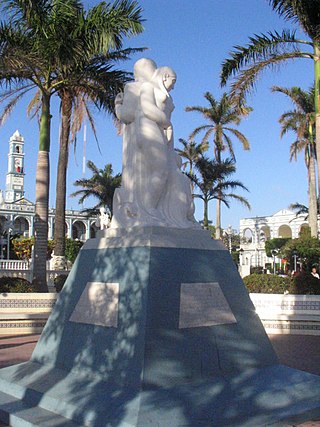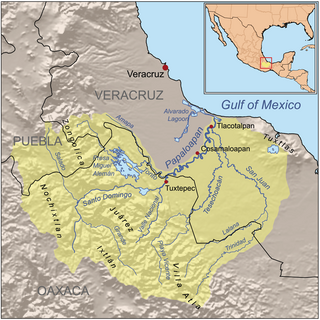
Veracruz, formally Veracruz de Ignacio de la Llave, officially the Free and Sovereign State of Veracruz de Ignacio de la Llave, is one of the 31 states which, along with Mexico City, comprise the 32 Federal Entities of Mexico. Located in eastern Mexico, Veracruz is bordered by seven states, which are Tamaulipas, San Luis Potosí, Hidalgo, Puebla, Oaxaca, Chiapas, and Tabasco. Veracruz is divided into 212 municipalities, and its capital city is Xalapa-Enríquez.

Tlacotalpan is a city in Tlacotalpan Municipality in the Mexican state of Veracruz, declared a World Heritage Site by UNESCO in 1998 primarily for its architecture and colonial-era layout. The town was established in 1550 on what was originally an island in the Papaloapan River. From the colonial era to the 20th century, it was an important port, one of few interior river ports in Latin America. However, with the construction of the railroad, Tlacotalpan's importance faded. Starting in the latter 20th century, efforts to conserve the city's Spanish/Caribbean architecture and layout began, culminating in World Heritage status. Today, its main economic support is fishing and tourism, especially to the annual feast in honor of Our Lady of Candlemas.

The Papaloapan River is one of the main rivers of the Mexican state of Veracruz. Its name comes from the Nahuatl papaloapan meaning "river of the butterflies".
Cosamaloapan is a city located in the plains of the Sotavento zone in the central zone of the State of Veracruz, about 240 km from state capital Xalapa. It has a surface of 323.26 km2. It is located at 18°22′N95°48′W.

Alvarado is a city in the Mexican state of Veracruz. The city also serves as the municipal seat for the surrounding municipality of the same name. It is located 64 km (40 mi) from the city of Veracruz, Veracruz, on Federal Highways 180 and 125. Alvarado is bordered by Boca del Río, Tlalixcoyan, Medellín, Ignacio de la Llave, Ciudad Lerdo de Tejada, Tlacotalpan and Acula. It is 10 m (33 ft) above sea level. It lies in the so-called "Region Papaloapan" bordered on the south by the municipalities of Acula, Tlacotalpan and Lerdo de Tejada, on the east by the Gulf of Mexico and on the west by Ignacio de la Llave.

Otatitlán is a town and municipality in the Mexican state of Veracruz, in the south of the state along the border with the state of Oaxaca. The town is best known for its large black image of a crucified Christ, one of three notable images of this type. Most of the population in Otatitlán is poor and the area is dedicated to agriculture, especially sugar cane and bananas.

San Juan Bautista Tuxtepec, or simply referred to as Tuxtepec, is the head of the municipality by the same name and is the second most populous city of the Mexican state of Oaxaca. It is part of the Tuxtepec District of the Papaloapan Region. As of the 2020 census, the city is home to a population of 103,609 and 159,452 in the municipality, though census data are often under reported for various reasons.
El Jícaro is a small town in the municipality of Tierra Blanca, in the Mexican state of Veracruz. It stands in the Río Papaloapan basin, at the 83rd kilometer of the Veracruz–Tierra Blanca railroad.

Santiago Tuxtla is a small city and municipality in the Los Tuxtlas region of southern Veracruz, Mexico. The area was originally part of lands granted to Hernán Cortés by the Spanish Crown in 1531. The city was founded in 1525, but it did not gain municipal status until 1932. Today, the municipality is poor and agricultural, but is home to several unique traditions such as the Santiago Tuxtla Fair and the Acarreo de Niño Dios, when images of the Child Jesus are carried in procession several times during the Christmas season. It is also home to the Museo Regional Tuxteco which houses much of the area's Olmec artifacts, including a number of colossal heads and other monumental stone works. The city's main plaza hosts the largest Olmec colossal head in Mexico, thus making it famous.
Alvarado is one of the 212 municipalities of the Mexican state of Veracruz. The municipality is part of the state's Papaloapan Region and its municipal seat is established at the homonymous city of Alvarado.
Lerdo de Tejada is a municipality in the Mexican state of Veracruz, located 207 kilometres (129 mi) southeast of the state capital Xalapa. It is named after Sebastián Lerdo de Tejada, the 27th President of Mexico.
Ixmatlahuacan is a municipality in the Mexican state of Veracruz. It is in south zone of Veracruz, about 175 km from the state capital Xalapa. It has an area of 335.59 km2. It is located at 18°27′N95°50′W. Ixmatlahuacan is delimited to the northeast by Acula, to the east by Amatitlán, to the south by Cosamaloapan, to the west by Tierra Blanca, and to the north by Ignacio de la Llave.

Loma Bonita is a town and municipality in Oaxaca, Mexico. It is part of the Tuxtepec District of the Papaloapan Region. As of 2020, the municipality had a population of 40,943.
San Juan Bautista Valle Nacional is a town and municipality in Oaxaca in south-western Mexico. The municipality covers an area of 394.23 km² within the Sierra Juárez mountains. It is part of the Tuxtepec District of the Papaloapan Region. The town lies on the north bank of the Valle Nacional River, a tributary of the Papaloapan River.

Tezonapa is a municipality located in the high mountain region in the State of Veracruz, Mexico, about 219 km from state capital Xalapa. It covers an area of 351 square kilometres (136 sq mi).
Tlacojalpan is a municipality located in the south zone in the State of Veracruz, Mexico, about 175 km (109 mi) from state capital Xalapa. It has a surface of 91.30 km2. It is located at 18°14′N95°57′W. The name comes from the language Náhuatl, Tlahco-xal-pan; that means “In the half of the sandbank".
The Cerro de Oro Dam, also called the Miguel de la Madrid Hurtado Dam, is on the Santo Domingo River in the San Juan Bautista Tuxtepec municipality of the Papaloapan Region of Oaxaca state in southern Mexico. The dam operates in conjunction with the Miguel Alemán Dam, located on the Tonto River to control floods in the Papaloapan basin in Veracruz state. Construction began in 1973 and the dam was completed in May 1989. About 26,000 people were displaced by the project. Water quality in the reservoir is poor and deteriorating, affecting fish catches.

The Santo Domingo River in Oaxaca state, Mexico is one of the main tributaries of the Papaloapan River. It is formed by the confluence of the Salado and Grande rivers, which drain the dry Tehuacán and Cuicatlán valleys west of the Sierra Madre de Oaxaca. The Santo Domingo river flows east through the Sierra Madre, dividing the Sierra Zongolica sub-range to the north from the Sierra Juárez to the south. It joins with the Valle Nacional River above San Juan Bautista Tuxtepec to form the Papaloapan.

The Cuenca del Papaloapan Region is in the north of the state of Oaxaca, Mexico where the foothills of the Sierra Madre de Oaxaca meet the coastal plain of Veracruz. The principal city is San Juan Bautista Tuxtepec, the second largest in Oaxaca state.
The current municipality of Ignacio de la Llave, previously known as San Cristobal de la Llave, is placed in the popularly known region of La Mixtequilla, which is located in the western limit of the Papaloapan river, going through the Blanco, Limón and Las Pozas rivers. The climate of the region varie between hot-humid and tropical-humid, with frequent summer rains between July and September. The average temperature is from 64 and 72 °F, with a maximum registered in the high 70s °F (24-26°C) and the lowest in the high 40 °F (7-9°C). Ignacio de la Llave is neighbor and has deep political, social and trading relationships with: Alvarado, Acula, Ixmatlahuacan, Tlalixcoyan and Tierra Blanca.





















